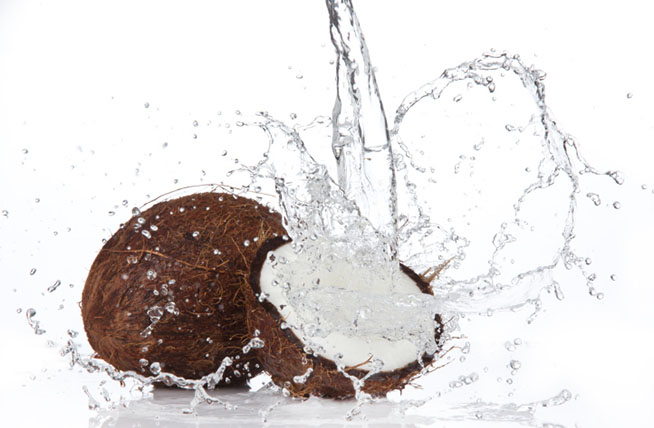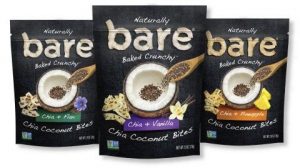Consumers lap up the tropical plant in water, milk, flour, oil and snacks
March 27, 2017 10:57 a.m. ET: If you feel like everything is starting to taste like a piña colada, it isn’t just you.
Coconut is in everything. Packaged soups, baby foods and snack foods are made with coconut oil, flour and shavings. Gyms are stocking coconut water. For some, coconut oil is a substitute for butter on popcorn, and coffee shops are spooning it liberally in blended lattés. The flavorful ingredient went from a garnish on a cake to a base in foods in part because consumers no longer worry about its fat content. It is also increasingly promoted as healthful: Coconut sugar has a lower glycemic index than ordinary sugar, nutritionists say, meaning it can cause blood sugar to spike less, which may help stave hunger. Consumers seek such plant-based foods because they can help them stick to popular diets, such as dairy-free or gluten-free.

Dang Foods sources its coconuts from Thailand at 8 months maturity, when founder Vincent Kitirattragarn says more meat and less water makes it better suited for chips. PHOTO: DANG FOODS
“Coconut water put it on the map,” says Lu Ann Williams, director of innovation at Innova Market Insights, which tracks food introductions. Coconut’s association with water, she says

Bare Natural Foods is combining two trendy foods – chia seeds and coconut – into a new ‘chia coconut’ snack. PHOTO: BARE SNACKS
“makes everything [coconut] seem healthy.” Coconut water took off a few years ago, as a natural sports drink high in electrolytes such as sodium and potassium. Then it became a darling of the dairy case, sold alongside soy milk and almond milk.
The number of coconut-containing product launches increased an average of 21% a year in the last five years, according to Innova.
Coconut follows in the footsteps of foods that have seen their names in lights before falling out of favor, from kale to broccoli rabe and sundried tomatoes. Such trends typically last two to five years and may be influenced by factors such as plentiful supply or scientific studies that demonstrate health benefits. “It’s going to wane,” says Liz Moskow, culinary director at Sterling-Rice Group, a Boulder, Colo.-based food consultancy. “I don’t think everything coconut is tasty.”
Bhavna Lee, a 39-year-old real-estate developer in Washington, D.C., says that since having her daughter Saara, 5, and son Ian, 4, she has turned to coconut oil as the go-to ingredient in fried foods and treats.
“They both like it so much they ask for a spoon of coconut oil before bed every night,” she says.
Coconut pieces are a popular alternative to potato chips. Bare Snacks, based in San Francisco, has more than doubled the number of its coconut-containing products in the last year to 10, including new coffee bean and sweet ginger flavored chips. This month it is launching a new line of coconut bites with chia seeds in 2.8-ounce bags for $4.
Berkeley, Calif.-based Dang Foods says its coconut chips are selling far more this year than last, and they contain “as much fiber, less sugar than an apple.” Founder Vincent Kitirattragarn says people tend to have strong feelings about coconut: About 80% of his coconut chip consumers are women. “I attribute that to the prevalence of coconut in beauty care,” so it is more familiar to them.
A common complaint is the mealy texture of coconut, which often gets stuck between teeth.

So Delicious coconut yogurts come in new fruit flavors such as peach and key lime, which the company says combine well with coconut. PHOTO: WHITEWAVE
“Getting to a smoother mouth feel is one big technical area” of development, says John Ghingo, president of plant-based foods and beverages for WhiteWave Foods, which markets So Delicious coconut milks and yogurts. For others, the flavor is too strong.

Coconut sugar is becoming more popular because it can make blood sugar spike less than other sugars. PHOTO: WHOLESOME SWEETENERS
“I am a strong and vocal hater of coconut,” says Lexa Lemieux, a 36-year-old executive operations manager at a trade association in Washington, D.C. “It tastes like suntan lotion and everyone tries to convince you to like it.”
Where does all the coconut come from, consumers may wonder. Three-fourths of global production comes from Indonesia, India and the Philippines, which are benefiting from the demand surge. In the Republic of Indonesia alone, coconut exports doubled to bring in $1.65 billion in 2014, up from $800 million in 2010, says Samit Chowdhury, who heads the Singapore-based Coconut Knowledge Center for Tetra Pak International, a Swiss-based food packaging company. Coconut prices nearly doubled in that time in India, and have gone up elsewhere as well, he says. Tetra Pak packaged over 800 million liters of coconut-based products in 2016, up from 710 million liters a year earlier.
Coconut products became such an important business for the company that Tetra Pak launched a Coconut Knowledge Centre in Singapore in 2012 to research the supply chain in response to growing demand, including running product and processing tests with regional universities.
Hain Celestial, a top maker of coconut oil, says drought conditions and typhoons that blew into the Philippines, its main supplier, have affected commodity prices for coconut oil, which are up between 5%

Spectrum coconut oil can be found in both food section and the beauty isle, as some people use it as a hair conditioner and to wipe off makeup. PHOTO: THE HAIN CELESTIAL GROUP, INC.
and 7% from a year ago. The company didn’t raise it is pricing, however. Its 14-ounce unrefined coconut oil is $8.42, down 12% from a year ago, says Leah Dunmore, vice president of marketing.
This year, Hain Celestial’s Jason line launched a Simply Coconut line of toothpastes and touts “made with coconut oil” on packages of its Terra Plaintain Chips. Coconut is a featured ingredient in 77 of the company’s products compared with just 20 five years ago.
Bob’s Red Mill Natural Foods says its coconut flour has risen to rank eighth in its lineup of over 60 flours. One of its appeals to dieters is that it is lower in carbohydrates than regular all-purpose flour and has more fiber, says marketing director Amanda Carter, though it has more calories and fat. The company’s coconut flour contains 14g of fat, 57 grams of carbs and 36 grams of fiber per 100 grams, according to the U.S. Agriculture Department’s National Nutrient Database. Its unbleached white all-purpose flour contains 1.5 grams of fat, 73.5 grams of carbs and 3 grams of fiber per 100 grams.
One caveat: Coconut flour is very absorbent and tends to create a dense consistency when baked, says Amanda Carter, marketing manager. The company recommends replacing just 20% of a typical recipe’s flour content with coconut flour.
By Anne Marie Chaker for The Wall Street Journal




